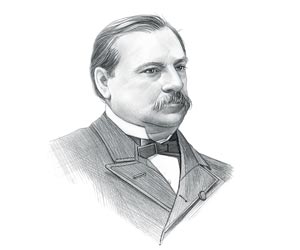|
|
|
|
|
Facts about
Panic of 1893 The Panic of 1893 started when the Philadelphia and Reading Railroad, one of the first railroads constructed in the United States, when bankrupt. By 1871, the Philadelphia & Reading Railroad had become the largest company in the world attracting many investors. The company continued to grow, became over confident in its power, invested in land speculation, coal mining and coal haulage and eventually over-extended its operations leading to its collapse. The president of the Philadelphia & Reading Railroad and the Philadelphia and Reading Coal and Iron Company was Franklin B. Gowen (February 9, 1836 – December 13, 1889), one of the 'Robber Barons' who emerged during the era. Gowen was a key industrialist involved in labor disputes during the Great Railroad Strike o f 1877 and played a major role in the downfall of the Molly Maguires. The Panic of 1893 began in the United States in February 1893 Major banks collapsed, ruined by over speculation of the Philadelphia & Reading Railroad in relation to the railroads. There were runs on state banks, leading to foreclosures and bankruptcies. 50 railroad companies were effected, construction was halted, more than 30 steel companies collapsed in the wake of the railroad failures, factories were closed, businesses were ruined and unemployment soared April 1893: The failure of major industries was followed by a crisis in the US Government. The U.S. Treasury’s gold reserves fell to below $65 million which sparked a financial panic as investors as investors panicked selling off assets and converting them to gold. The government limited the supply of money by tying the US dollar to gold. The gold supply had dropped and the federal government reduced the number of dollars that were printed. The government had attempted to address the gold shortage issue in 1890 by authorizing Sherman Silver Purchase Act enabling the Treasury to issued dollars backed by silver, as well as gold. Devalued US Currency: The action of backing US currency with silver resulted in the dollar losing its value. Foreign lenders lost confidence in the devalued US currency, dollar loans were called and converted into gold. President Cleveland repealed the Silver Purchase Act but this failed to reduce the panic. The gold standard had a disastrous effect on the nation's farmers who were unable to obtain low-interest credit to sustain their businesses. The invention of the Mechanical Reaper and the Grain Elevators had led to over-production resulting in the fall of crop prices. Farmers could not raise grain prices and thousands of farmers lost their homes and their land. The number of foreclosures and bankruptcies increased. The prices of manufactured products dropped, inflation rose and credit was not available. Thousands of Americans became unemployed from railroad to factory workers and farmers, many lost their homes as well as their livelihoods, became destitute and depended on the charity of others to survive. May 1893: The collapse of the National Cordage Company, the nation’s leading manufacturer of rope and twine, on 4 May, 1893 exacerbated the financial crisis. The national unemployment rate approached 20% - the worst levels in US history. It is estimated that 2.5 million desperate, jobless men moved from city to city looking for work. Within a year of the crash over 125 railroads went into receivership. Over 15,000 companies and 600 banks were forced to close down. Wage levels also dropped. The depression led to wages being drastically reduced which led to over 1000 strikes, involving 750,000 workers, across the country. The strikes led to violent clashes between workers and the army as experienced in the Pullman Strike and the national strike by the United Mine Workers of America. A group of the unemployed called "Coxey’s Army" marched to Washington in protest - the leaders were arrested. The banker J.P. Morgan bailed out the federal government by loaning the Treasury $65 million dollars in gold enabling the Treasury to issue bond sales. By the end of February 1896, the US Treasury reserve finally reached over the $100 million mark 1896: The discovery of gold in the Klondike in 1896 finally ended the four year depression |
| US American History |
| 1881-1913: Maturation Era |
|
|
|
|
|
First Published2016-04-19 | |||
|
Updated 2018-01-01 |
Publisher
Siteseen Limited
| ||
|
|

